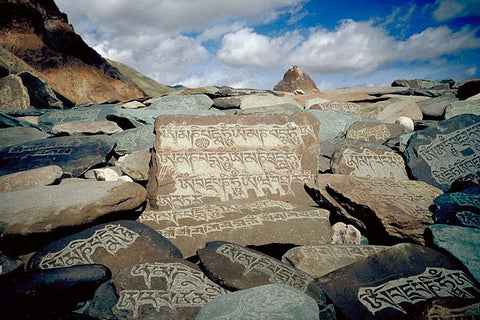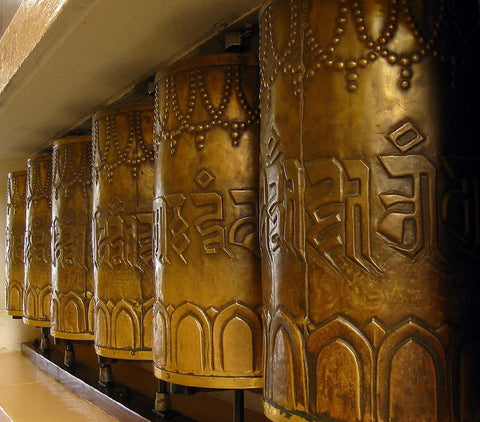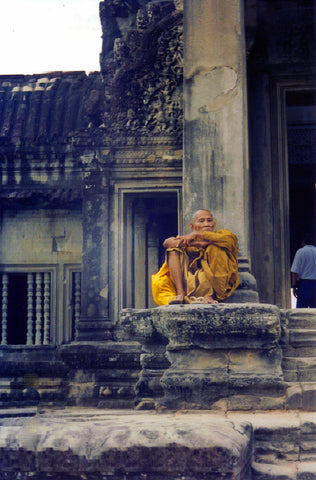Your Cart is Empty
Free Shipping for orders over $49 in Australia, $199 IN NEW ZEALAND/USA/CANADA AND $249 REST OF THE WORLD
Free Shipping for orders over $49 in Australia, $199 IN NEW ZEALAND/USA/CANADA AND $249 REST OF THE WORLD
Add description, images, menus and links to your mega menu
A column with no settings can be used as a spacer
Link to your collections, sales and even external links
Add up to five columns
Add description, images, menus and links to your mega menu
A column with no settings can be used as a spacer
Link to your collections, sales and even external links
Add up to five columns
Om Mani Padme Hum – the Mantra of Compassion
by Linda Heaphy July 03, 2017

Along the paths of Zanskar, in the eastern half of the Indian state of Jammu and Kashmir, the traveller will find so called "Mani walls", carved stones each with the inscription Om Mani Padme Hum. Traditionally these stones should be circumvented from the left side, the clockwise direction in which the earth and the universe revolve according to Buddhist belief. Photo credit: Shakti
In Sanskrit: ॐ मणिपद्मे हूं
A mantra may be defined as a sacred utterance, consisting of a single or group of sounds, syllables, words or phonemes. One of the best known and loved of all mantras is Om Mani Padme Hum. Its six syllables roughly translate to:
Om – “hail”, a sacred sound and the first uttered out loud in the newly created universe
Mani – jewel or bead
Padme – lotus flower
Hum – the embodiment of enlightenment
Together the syllables literally mean Hail, jewel in the lotus, where lotus-jewel is one of the many names of Avalokiteswara, bodhisattva of compassion. However, the significance of the mantra goes much deep than mere literal translation. The late Dilgo Khyentse, Rinpoche and head of the Nyingma school of Tibetan Buddhism from 1987 to 1991, provides one interpretation:
The mantra Om Mani Pädme Hum is easy to say yet quite powerful, because it contains the essence of the entire teaching. When you say the first syllable Om it is blessed to help you achieve perfection in the practice of generosity, Ma helps perfect the practice of pure ethics, and Ni helps achieve perfection in the practice of tolerance and patience. Pä, the fourth syllable, helps to achieve perfection of perseverance, Me helps achieve perfection in the practice of concentration, and the final sixth syllable Hum helps achieve perfection in the practice of wisdom.
Although its origins date to at least the 1st century CE, deriving from a chant associated with the Hindu god Shiva, the mantra first appears in Buddhist doctrine via the Karandavyuha Sutra (4 or 5th century CE), where it is associated with Avalokiteswara – indeed, one of his names is Ṣaḍākṣarī, meaning "Lord of the Six Syllables". The mantra is considered to be at the very heart of the concept of Avalokiteswara, defining him as the embodiment of compassion. When reciting Om mani padme hum, one is said to “harmonise in the choral resonance of pure compassion”, in turn producing a calming and healing effect on the chanter. Ultimately, recitation of the mantra is capable of bringing about enlightenment and salvation, both for individuals and for the world at large.
In antiquity, many Buddhist mantras with different meanings and purposes have gained ascendancy over others. However, in our modern world, a time of uncertainty and heartlessness fuelled by mass media paradigms and polarisation of geographical politics, Om Mani Padmi Hum has become the most recognised and revered of all mantras, the most frequently invoked. It is often found inscribed on jewellery, on objects of importance, on stones and walls, on pieces of paper (for example, when inserted thousands of times over into prayer wheels), on prayer flags and across many other devices as a form of protection. Tibetans and Nepalese recite the mantra and invoke Avalokiteswara during times of danger or hardship. The Dalai Lama is believed by Tibetan Buddhists to be an incarnation of Avalokiteswara, increasing its popularity and helping to spread its message of kindness throughout the world, making Om mani padme hum a right and fitting mantra for our time.

Large brass prayer wheels surrounding the Tsuglagkhang Temple (also known as the Dali Lama temple) in McLeod Ganj, a suburb of Dharamshala in the Kangra district of Himachal Pradesh, India, where the Dali Lama currently resides. Payer wheels are always turned in a clockwise direction, in keeping with Buddhist doctrine. Photo credit: Liz Highleyman
References and Further Reading:
Buswell, Robert E. Jr. & Lopez, Donald S. Jr. 2014. The Princeton Dictionary of Buddhism. Princeton University Press, Princeton, NJ.
Dilgo Khyentse Rinpoche and Patrul Rinpoche, 1992. Heart Treasure of the Enlightened Ones[. Shambhala Publications.
Kāraṇḍavyūhasūtra. Wikipedia. Accessed 30th June 2017
Mantra. Wikipedia. Accessed 30th June 2017
Om Mani Padmi Hum Wikipedia. Accessed 30 June 2017
Studholme, Alexander 2002. The Origins of Om Manipadme Hum. State University of New York Press, Albany NY ISBN 0-7914-5389-8
If you liked this article, please visit our online store
Leave a comment
Comments will be approved before showing up.
Also in Symbols & Ritual Objects
Articles
About the Author
- Linda has a Honours degree in Marine Biology and a PhD in Ecology from the University of NSW, Australia. She has travelled extensively and is a passionate writer on subjects as diverse as the role played by women throughout history, tribal communities and their customs, symbology and ethnology, talismans and their history. Occasionally she also writes about her travel experiences, her new life on a 25 acres in the Northern Rivers region of northern Australia and her black miniature poodle Phoenix. She is currently writing her first book on talismans.
About Us
-
The Kashgar Philosophy

Kashgar began through a love of travel.
In 1989 my father Bernard packed in his house painting business and set off for two years on a backpacking trek to the remotest corners of the world. When he finally arrived in the oasis city of Kashgar, China, he was so impressed with its history that he decided to start a new life collecting and selling exotic goods from all over the world. For 2000 years the legendary city of Kashgar was a melting pot of ideas and a key trading post on the historic Silk Road. It was this unique combination of philosophy and trade that my father wanted to recreate at home.
Starting in markets in 1991, he opened his first store in the Sydney suburb of Newtown in 1994. I gave up my own career as a government scientist to join him in 2000 and soon convinced my partner Ian to join us in what was to become the Family Business.
Today our version of Kashgar stocks a hugely diverse range of furniture, rugs, textiles, antiques, handicrafts and jewellery sourced from over twenty different countries including India, Nepal, Tibet, China, Thailand, Burma, Laos, the Philippines, Vietnam, Mexico, Peru, Turkey, Palestine, Syria, Afghanistan and Turkmenistan. Our collection includes contemporary and tribal silver and gold jewellery, a unique range of headhunting curios, antique Buddhist relics and a collection of one-off necklaces, earrings and bracelets that I design and create myself using the beads and jewellery making techniques of ethnic minorities from around the globe.
Kashgar is a philosophy as well as a store. We are committed to supporting traditional artisans and small village communities by selling authentic handcrafted goods which are personally collected by us. By supporting traditional methods of design and production we hope to encourage local cottage industries which have a low impact on the environment and help ethnic minorities maintain their self-sufficiency into the 21st Century. We are particularly committed to assisting women around the world and to this end have worked with several organisations including the Hua Bin Women's Union of Vietnam, the East Timorese Women's Association and Tikondane in Zambia. Time honoured means of craftsmanship and traditional ways of life are disappearing as people all over the world give up their identity in favour of jeans and T-shirts. We see our trade as a means of staving off the inevitable encroachment of the 21st century, assisting communities to decide for themselves which parts of the western world they wish to incorporate (medicine, education) and which they wish to reject (prostitution, drug production, begging and servitude to warlords). We encourage our customers to think of the handicrafts and artifacts they buy from us as an investment: a piece of history and a way of life that may soon be gone forever.
Kashgar has recently closed its retail outlet and gone completely online.
In the past our pieces appeared in many movies including The Hobbit, Mission Impossible 2, Queen of the Damned, Scooby Doo, Moulin Rouge and Wolverine, and in many televisions series, as well as in plays, commercials and exhibitions. We've found special pieces for individual customers as well as for film sets, event management companies, hotels, businesses, consulates and embassies. The uniqueness of our stock means that we are also very appealing to interior and fashion designers with a taste for the exotic.
There is something for everyone at Kashgar - collectors, the curious, those looking for a special present or for something unique to adorn the home. Most of our items are one-off specialties; other pieces we only stock in small quantities so as to continuously offer a wide and ever-changing range of interesting products. We are also packed with ideas for decorating home and work premises that will challenge your established concepts of design and storage.

Please enjoy - Linda Heaphy
Become a Kashgar nomad and join our mailing list...
Sign up to get the latest on sales, new releases and more …

 The mantra Om mani padme hum commonly appears on jewellery originating in Thailand, Nepal and Tibet. Photo credit: Kashgar
The mantra Om mani padme hum commonly appears on jewellery originating in Thailand, Nepal and Tibet. Photo credit: Kashgar




